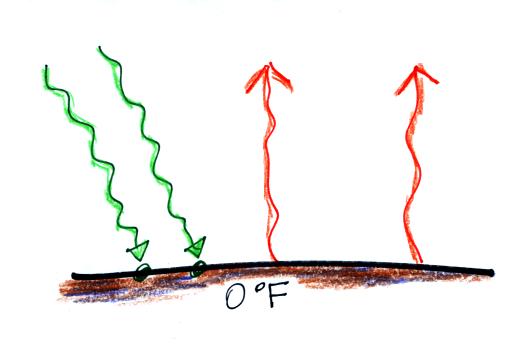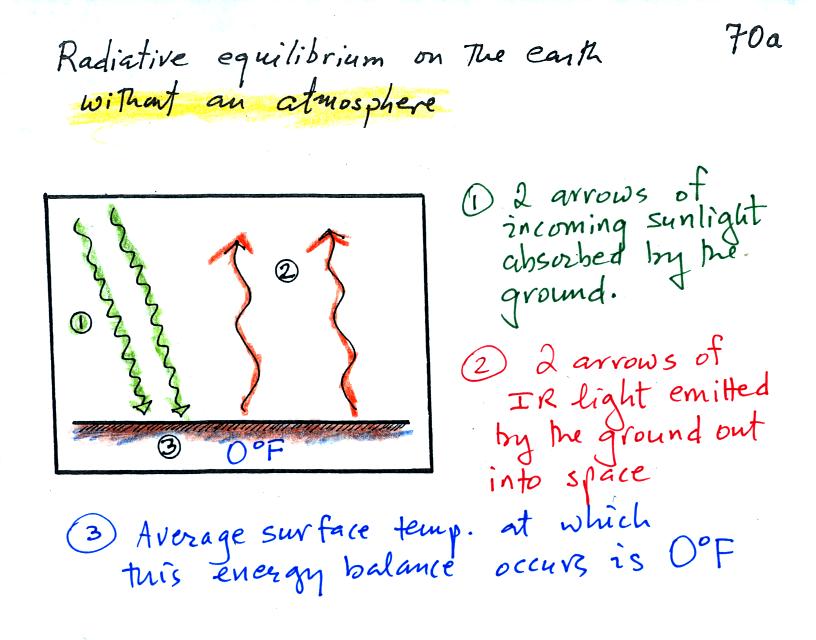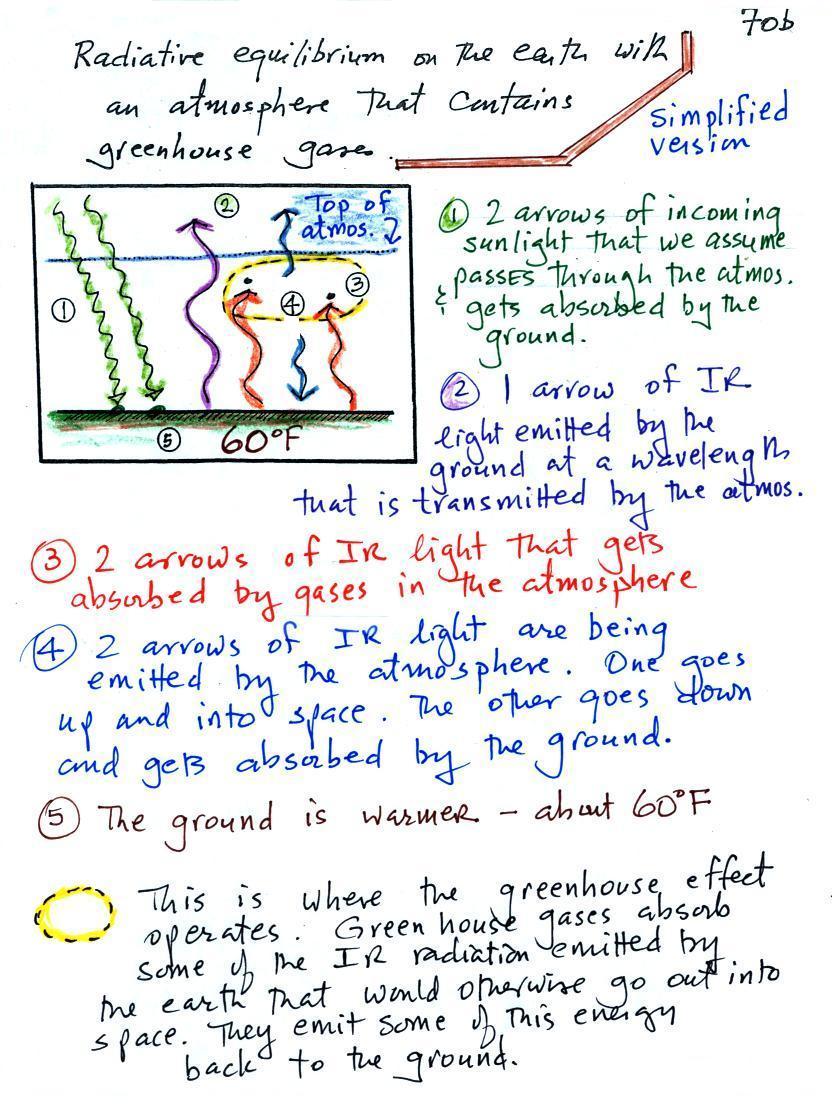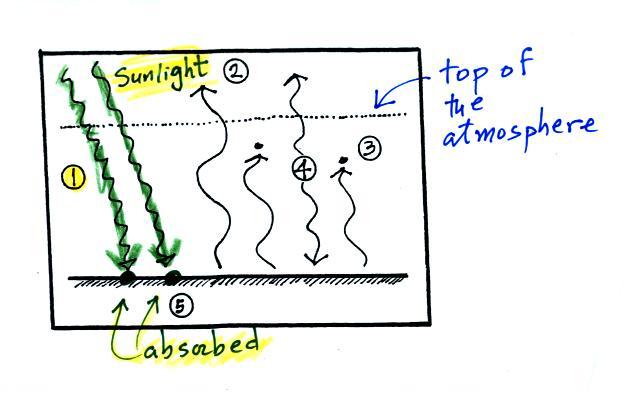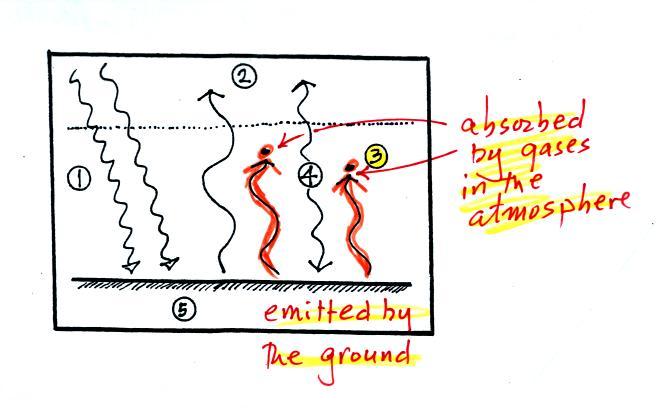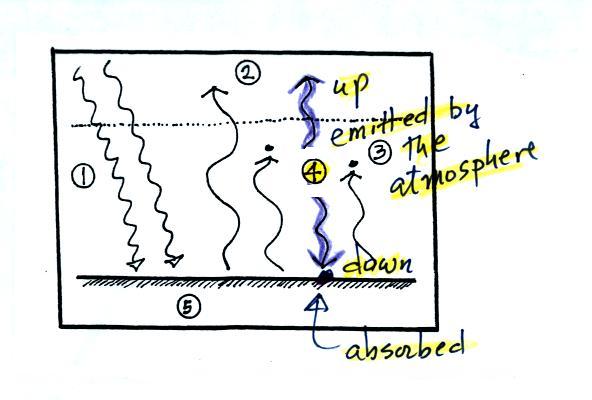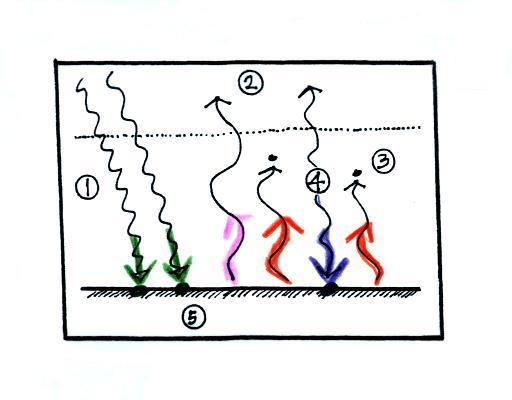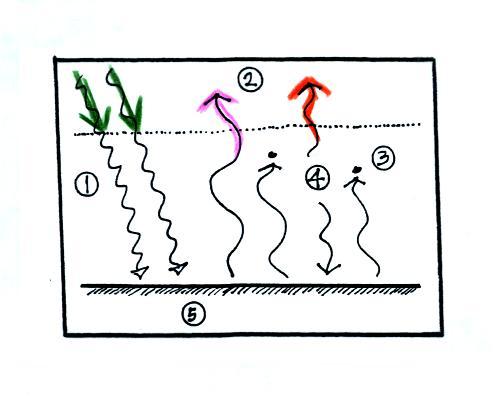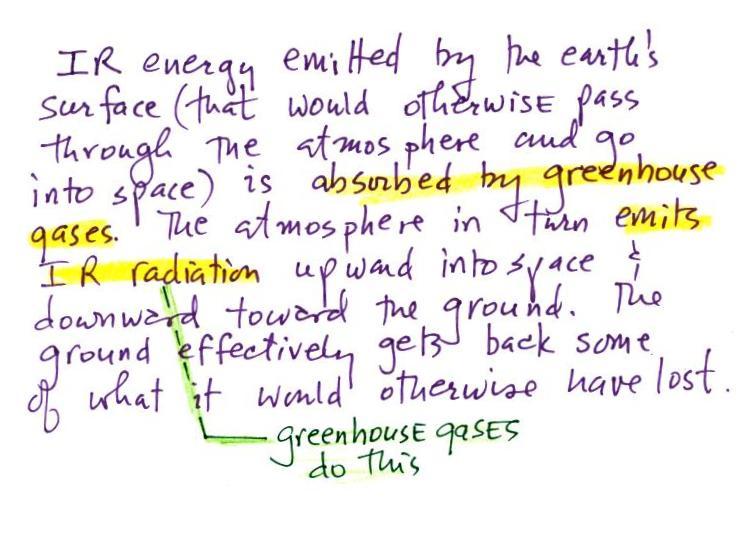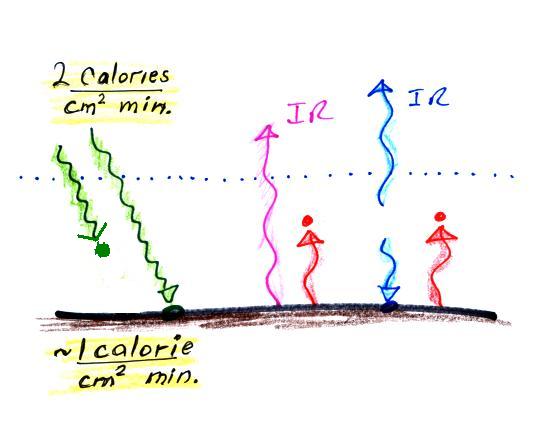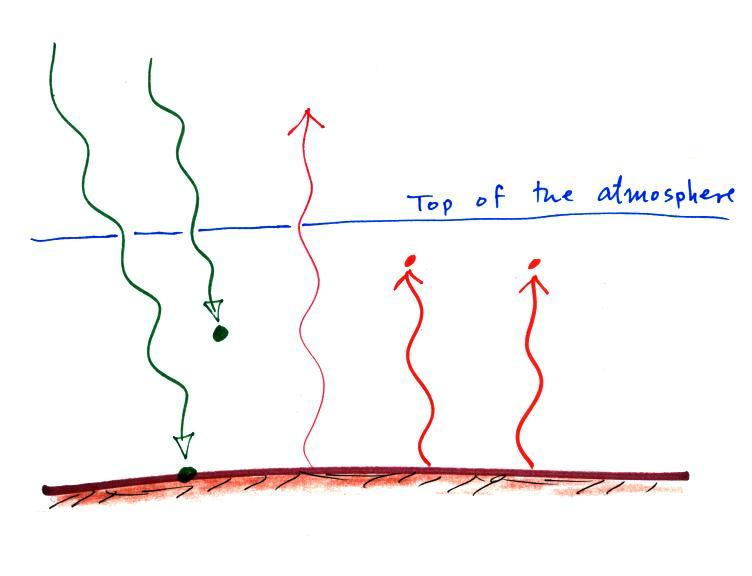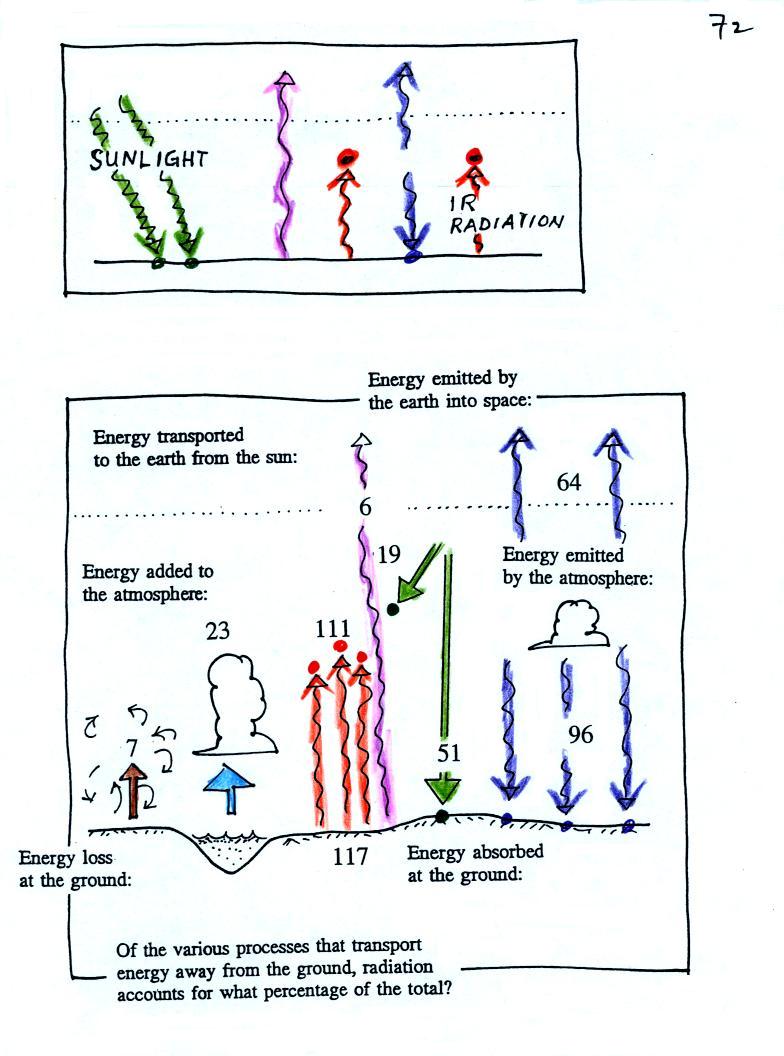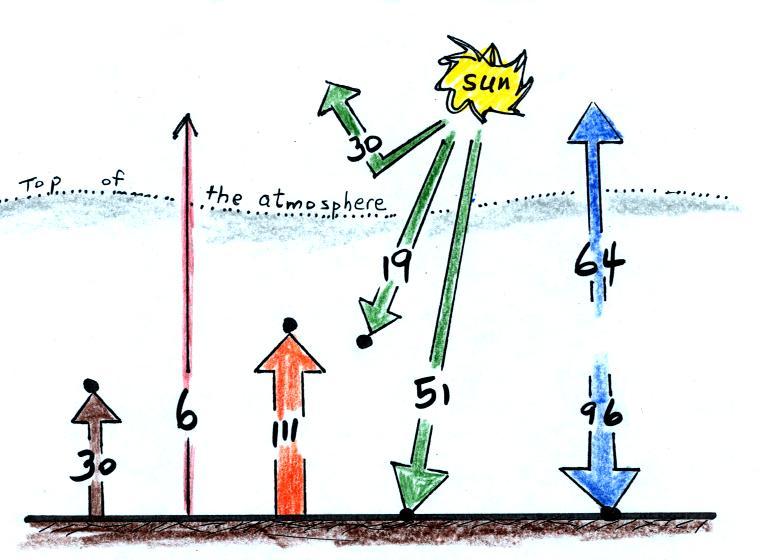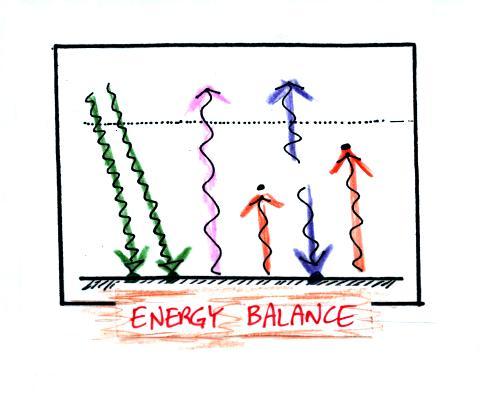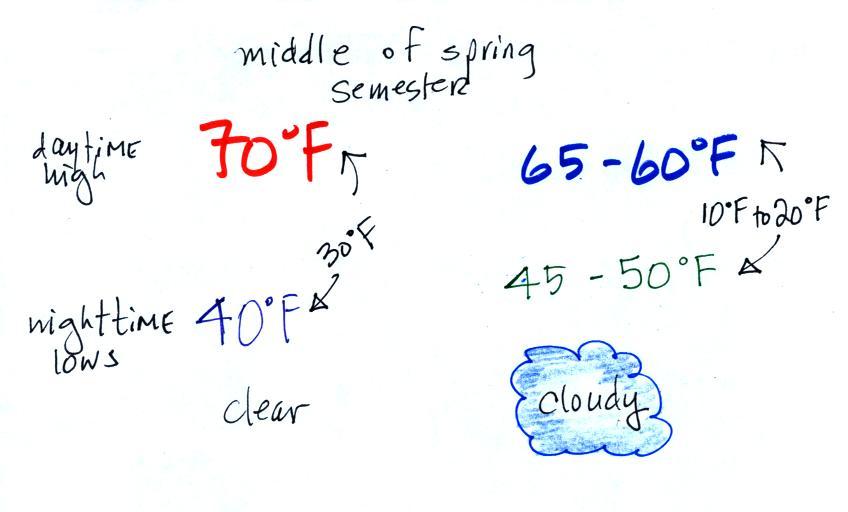The important
thing is that there are equal
amounts being absorbed and emitted in both cases.
Here's the same picture with some
more information added (p. 70a in the photocopied ClassNotes).
This
represents energy balance on the earth without an atmosphere.
The next
step is to add an atmosphere, one that contains greenhouse gases, and
see how that changes the picture.
We will study a simplified
version
of radiative equilibrium just so you
can identify and understand the various parts of the picture.
Keep an eye out for the greenhouse effect. Here's a cleaned
up version of what
we ended up with in class (I added a little information at the bottom
of the picture.
It would be hard to sort through and try to understand all of this
if you weren't in
class
(difficult even if you were in class). So below we
will go through it again step by step (which you are free to skip over
if you wish). This might be a little more detailed version than
was done in class. Caution:
some of the colors below may differ
from those used in class.
1. In this
picture we see the two
rays of incoming sunlight that
pass through the atmosphere, reach the ground, and are absorbed.
100% of the incoming sunlight is transmitted by the atmosphere.
This wouldn't be too bad of an assumption if sunlight were just visible
light. But it is not, sunlight is about half IR light and some of
that
is going to be absorbed. But we won't worry about that at this
point.
The ground is emitting
a total of 3 arrows of IR radiation. At this point that might
seem like a problem. How can the earth emit 3 arrows when it is
absorbing only 2. We'll see how this works out in a second.
2. One
of
these
(the
pinkish
arrow
above)
is
emitted
by
the
ground
at
a
wavelength
that
is
not absorbed
by greenhouse gases in the atmosphere (probably around 10
micrometers). This
radiation passes through the atmosphere and goes out into space.
3. The other 2
units of IR radiation emitted by
the
ground are
absorbed by
greenhouse gases is the atmosphere.
4. The
atmosphere is absorbing
2 units of radiation.
In order to be in radiative equilibrium, the atmosphere must also emit
2
units of radiation. That's shown above. 1
unit of IR radiation is sent upward into space, 1 unit is sent downward
to the ground where it is absorbed. This is probably the part of
the picture that most students have trouble visualizing (it isn't so
much that
they have trouble understanding that the atmosphere emits radiation but
that 1 arrow is emitted upward and another is emitted downward toward
the ground.
Before we go any further we will
check
to be sure that
every part
of this picture is in energy balance.
The ground is absorbing
3 units of energy (2 green
arrows of sunlight and one bluish arrow coming from the atmosphere) and
emitting
3
units of energy (one pink and two red arrows). So the ground is
in energy balance.
The atmosphere is
absorbing 2 units of energy (the 2
red arrows coming from the ground) and
emitting 2
units of
energy (the 2 blue arrows). One goes upward into space. The
downward arrow goes all the way
to the ground where it gets absorbed (it leaves the atmosphere and gets
absorbed by the ground). The atmosphere is in energy balance.
And we should check to be sure equal amounts of energy
are arriving at and leaving the earth. 2 units of energy arrive
at the top of the atmosphere (green) from the sun after traveling
through space, 2 units
of
energy (pink and orange) leave the earth and head back out into
space. Energy balance here too.
The greenhouse effect involves the absorption and
emission
of IR radiation by the atmosphere. Here's how you might put it
into words
Doesn't it make sense that if the
ground is getting back some of
the energy it would otherwise lose, the ground will end up being
warmer. That's what the greenhouse effect does, it warms the
earth's surface. The global annual average surface temperature is
about 60
F on the earth with a greenhouse effect. It would be about 0 F
without the greenhouse effect.
Here are a couple other ways of understanding why the greenhouse
effect warms the earth.
The picture at left is
the earth without an atmosphere (without a greenhouse effect). At
right the earth has an
atmosphere, one that contains greenhouse gases.
At left the ground
is getting 2 units of energy (from the sun). At right it is
getting three, two from the sun and one from the atmosphere (thanks to
the greenhouse effect).
Doesn't it seem
reasonable
that ground that absorbs 3 units of energy will be warmer than ground
that is only absorbing 2?
Here's another explanation of why the ground is warmer with a
greenhouse effect than without.
At left the ground is emitting 2 units of energy, at
right the ground is emitting 3 units. Remember that the amount of
energy emitted by something depends on temperature. The ground
in the right picture must be warmer to be able to emit 3 arrows of
energy rather than 2
arrows. It is able to emit 3 arrows of energy even though it only
gets 2 arrows of sunlight because it is able to get a 3rd arrow of
energy from the atmosphere.
At this point we watched a couple
of video tapes that showed Experiment #3. One of the tapes was
produced by a NATS 101 student (ATMO 170A1 used to be called NATS 101).
The object of Experiment #3 is to measure the energy in sunlight
arriving at the ground here in Tucson.
So let's go back and look at some of the unrealistic
assumptions we made in our simplified version of the atmospheric
greenhouse effect.
One of the first things we did was to assume that
100% of the sunlight arriving at the earth passed through the
atmosphere and got absorbed at the ground (top figure below).
The bottom figure
above shows that on average (over the year and over the globe) only
about 50% of the incoming sunlight
makes it through the atmosphere and gets absorbed at the ground.
This is the only number in the figure you should try to remember.
About 20% of the incoming sunlight is absorbed by gases in the
atmosphere. Sunlight is a
mixture of UV, VIS, and IR light.
Ozone and oxygen will absorb a lot of the UV (though there isn't much
UV in sunlight) and greenhouse gases will absorb some of the IR
radiation in sunlight (roughly half of sunlight is IR light).
The remaining 30% of the incoming sunlight is reflected or
scattered back into
space
(by the ground, clouds, even air molecules).
Student performing Experiment #3 will be measuring the amount of
sunlight energy arriving at the ground. About 2 calories pass
through a square centimeter per minute at the top of the
atmosphere. Since about half of this arrives at the ground on
average, students should expect to get an answer of about 1
calorie/cm2 min.
Now that we know a little bit more
about the fate of incoming sunlight we'll improve our simplified
illustration of the greenhouse effect somewhat. We'll make it a
little more realistic.
In this case we'll assume that 1 of the 2 incoming arrows of sunlight
is absorbed in
the atmosphere instead of passing through the atmosphere and being
absorbed at the ground. The ground is still
emitting 3 arrows of IR light. What would you need to add to this
picture to bring it into energy balance?
Start with the atmosphere. How
many units does it need to emit. It's absorbing 3 units or energy
and must, therefore, emit 3 arrows of radiation. How many should
we draw going upward, how many go downward?
We'll next look at the ground. It is absorbing 1 unit of sunlight
energy but emitting 3. Thus we should send 2 of the 3 arrows of
radiation emitted by the atmosphere downard toward the ground.
We'll send the remaining arrow of energy emitted by the atmosphere
upward and into space.
The atmosphere is emitting 3 arrows
of IR light. 1
goes upward and into space, the other two go downward and get absorbed
by the ground.
Next we
will look at pretty realistic picture of energy balance on the earth
(the bottom figure below). The simplified version that we worked
out earlier in the class is also shown for comparison (top figure).
In the top figure (the simplified
representation of energy balance) you should recognize the incoming
sunlight
(green),
IR emitted by the ground that passes through the atmosphere (pink or
purple), IR
radiation emitted by the ground that is absorbed by greenhouse gases in
the atmosphere (orange) and IR radiation emitted by the atmosphere
(dark blue).
The lower part of the figure is
pretty complicated. It
would be
difficult to start with this figure and find the greenhouse effect in
it. That's why we used a simplied version. Once you
understand the upper figure, you should be
able to find and understand the corresponding parts in the lower figure
(especially since I've tried to use the same colors for each of the
corresponding parts).
In class today we looked at a slightly clearer version of the figure
above. It's shown below.
Sunlight is shown in green. 30 units are reflected, 19 are
absorbed by gases in the atmosphere (greenhouse gases absorb IR, ozone
and oxygen absorb UV light), 51 units pass through the atmosphere and
get absorbed at the surface. IR radiation emitted by the surface
is shown in orange. The majority of this is absorbed by
greenhouse gases in the atmosphere (111 units). Only 6 units are
able to pass through the atmosphere and go out into space. The
atmosphere emits IR radiation upward into space (64 units) and downward
toward the ground where it gets absorbed (96 units). And finally
to bring everything into energy balance: conduction, convection and
latent heat, at far left, transport 30 units from the surface up to the
atmosphere.
The
figure above came with three questions. Here's the first
Temperature is the first thing you should think of when asked to
explain about different amounts of energy being emitted by
something. The amount of energy emitted by an object depends on
temperature (the Stefan Boltzmann law E = σT4). The
lower atmosphere might be warmer than the upper atmosphere.
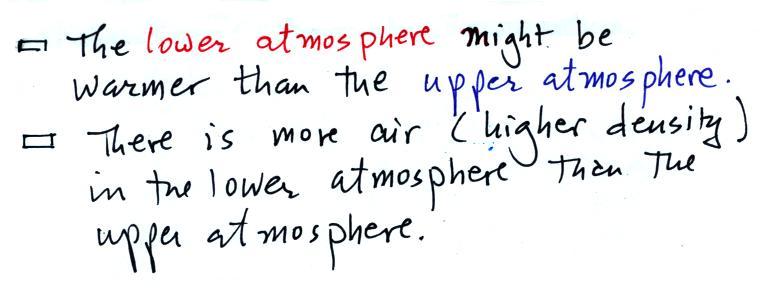
You might also ask what is doing
the emitting. If there weren't any air the atmosphere wouldn't be
emitting any radiation. The lower atmosphere is denser and has
more air than the upper atmosphere. So it seems reasonable that
the lower atmosphere is emitting more energy than the upper atmosphere.
We're used to thinking of the sun as the source of essentially all
of
the earth's energy.
But, on average, the ground is losing nearly 3 times as much
energy (30 + 6 + 111 = 147 units) as its getting from the sun (51
units).
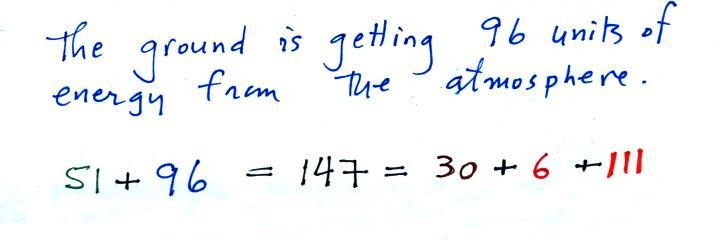
But the surface effectively gets a
lot of this back, thanks to the greenhouse effect. The atmosphere
emits 96 units of EM radiation downward to the ground. This
brings the ground into energy balance.
Here's something that seems even more amazing.
The earth's surface receives, on average, almost twice as much energy
from the atmosphere as it does from sunlight.
Here's part of the reason for this. The sun shines on
the surface for roughly half the day (depending on time of year).
The atmosphere is "shining" on the surface all the time.
Remember too that some of the incoming sunlight energy gets absorbed by
the atmosphere (the 19 units). The atmosphere then emits energy
downward toward the ground. So we're getting some of the sunlight
energy indirectly, the atmosphere is acting as a "middleman."
We'll use
our simplified representation of radiative equilibrium to understand
enhancement of the greenhouse effect and global warming.
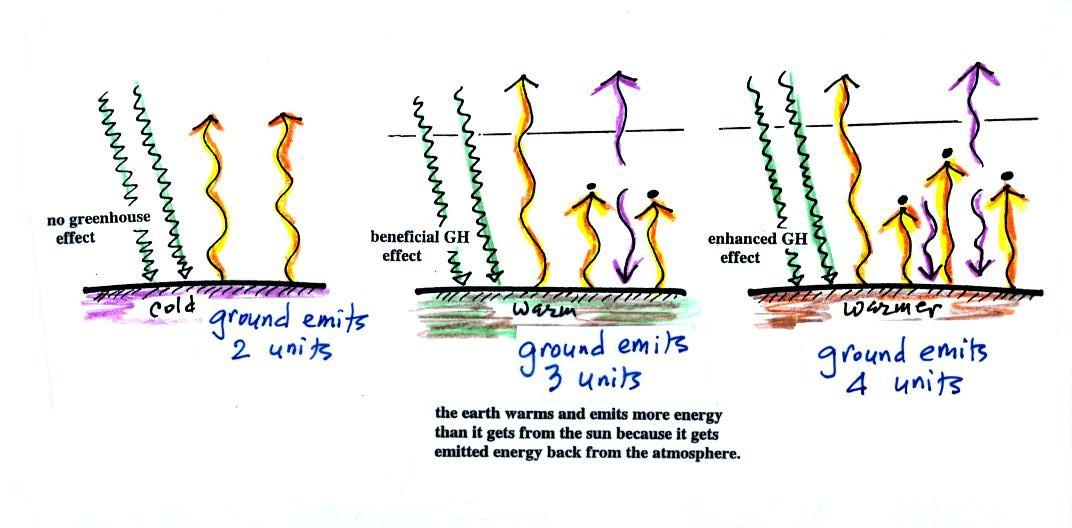
The figure (p. 72c in the
photocopied Class Notes) on the
left
shows
energy balance on the earth
without
an atmosphere (or with an atmosphere that doesn't contain greenhouse
gases). The ground achieves energy balance by emitting only 2
units of energy to balance out what it is getting from the sun.
The ground wouldn't need to be
very warm to do this.
If you add an atmosphere and greenhouse gases, the atmosphere will
begin to absorb some of the outgoing IR radiation. The atmosphere
will also begin to emit IR radiation, upward into space and downard
toward the ground. After a period of adjustment you end up with a
new energy balance. The ground is warmer and is now emitting 3
units of energy even though it is only getting 2 units from the
sun. It can do this because it gets a unit of energy from the
atmosphere.
In the right figure the concentration of greenhouse gases has
increased
even more (due to human activities). The earth would find a new
energy balance. In this case the ground would be warmer and would
be emitting 4 units of energy, but still only getting 2 units from the
sun. With more greenhouse gases, the atmosphere is now able to
absorb 3
units of the IR emitted by the ground. The atmosphere sends 2
back to the ground and 1 up into space.
The next figure shows a common misconception about the cause of
global
warming.
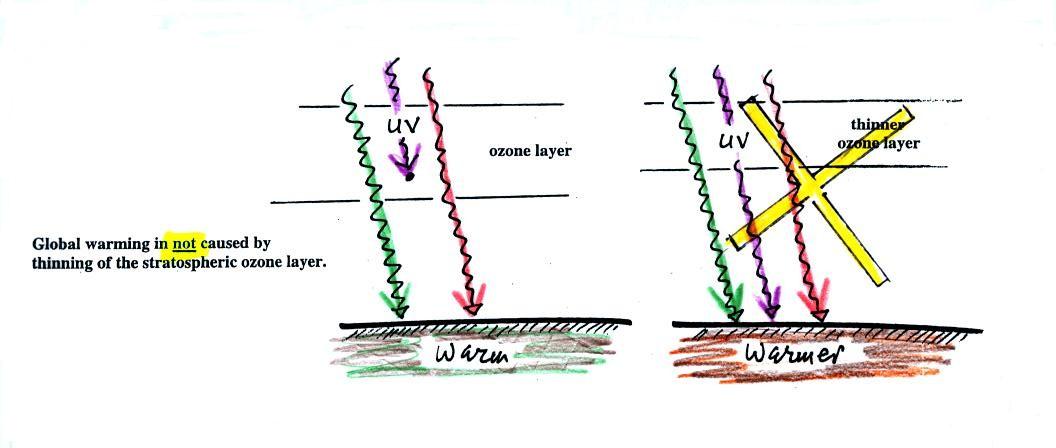
Many people know that sunlight
contains UV light and that
the ozone
absorbs much of this dangerous type of high energy radiation.
People also know that release of chemicals such as CFCs are destroying
stratospheric ozone and letting some of this UV light reach the
ground. That is all
correct.
They then conclude that it is
this additional UV energy reaching the ground that is causing the globe
to warm. This
is not correct. There isn't much (about 7%) UV light in
sunlight in
the
first place and the small amount of additional UV light reaching the
ground won't be enough to cause global warming. It will cause
cataracts and skin cancer and those kinds of problems but not global
warming.
If all of the UV light in sunlight were to reach the ground it
probably would cause some warming. But it probably wouldn't
matter because some of the shortest wavelength and most energetic forms
of UV light would probably kill us and most other forms of life on
earth.
And finally something we didn't
cover in class and a topic that won't be on this week's quiz.
The
effects of clouds on daytime high and nighttime low temperatures.
The following can be found on pps.
72a & 72b in the ClassNotes (I've rearranged things slightly to
make it clearer)
Here's the simplified picture of
radiative equilibrium again (you're probably getting pretty tired of
seeing this). You should be able to say something
about every arrow in the picture. The
two pictures below show what happens at night
when you remove
the
two green rays of incoming sunlight.
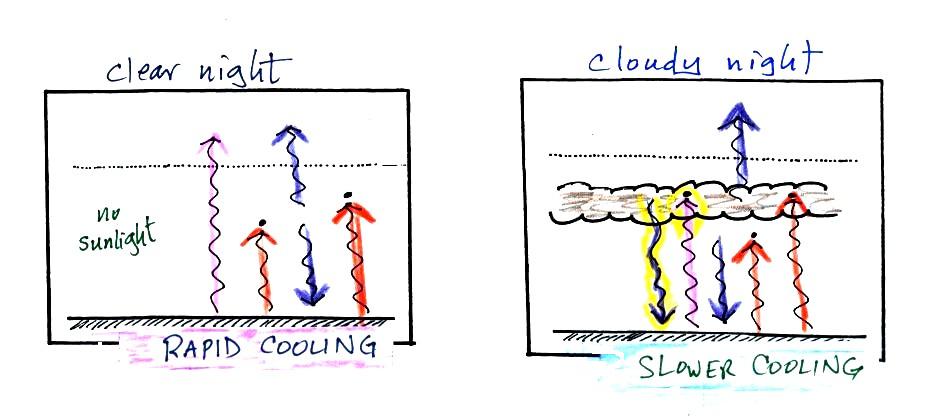
The picture on the left shows a
clear night. The ground is losing
3
arrows of energy and getting one back from the atmosphere. That's
a
net loss of 2 arrows. The ground cools rapidly and gets cold
during
the night.
A cloudy night is shown at right. Notice the effect of the
clouds.
Clouds are good absorbers
of infrared
radiation. If we could see IR light,
clouds would appear black, very different from what we are used
to (because clouds also emit IR light, if we could see IR light the
clouds might also
glow). Now none of
the IR radiation emitted by the ground passes through the atmosphere
into space. It is all absorbed either by greenhouse gases or by
the
clouds. Because the clouds and atmosphere are now absorbing 3
units of
radiation they must emit 3 units: 1 goes upward into space, the other 2
downward to the ground. There is now a net loss at the ground of
only
1 arrow.
The ground won't cool as quickly and won't get as cold on a cloudy
night as it does on a clear night. That makes for somewhat warmer
early
morning bicycle rides this time of the year.
The next two figures compare clear and cloudy days.
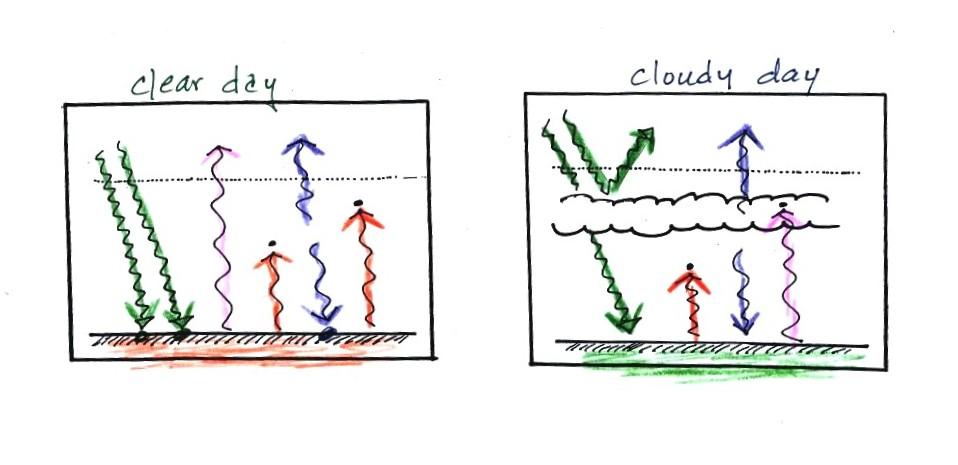
Clouds are good reflectors
of visible
light (we see visible light and clouds appear white). The effect
of this is to
reduce the amount of sunlight energy reaching the ground in the right
picture. With less sunlight being absorbed at the ground, the
ground
doesn't need to get as warm to be in energy balance.
It is generally cooler during the day on a cloudy day than on a
clear
day.
Clouds raise the nighttime minimum temperature and lower the
daytime
maximum temperature. Here are some typical daytime high and
nighttime
low temperature values on clear and cloudy days for this time of the
year.

